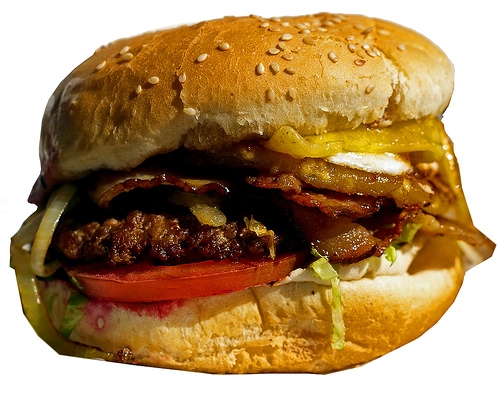In Meat Wagon, we round up the latest outrages from the meat and livestock industries.
———
Few who saw the documentary Food Inc. will forget the scene involving Beef Products Inc., a South Dakota company that makes a widely used hamburger filler product.
No other industrial-meat company allowed director Robert Kenner to enter the shop floor with his cameras. In sharp contrast, a Beef Products executive invited the Food Inc. crew to record his company’s inner workings. The man is clearly proud of his company’s product. “We think we can lessen the incidence of E. Coli 0157:H7,” he says.
The scene, a clip of which appears above, features the Beef Products executive talking over a scene straight out of Chaplin’s Modern Times: a vast network of steaming tubes, with people in protective gear and face masks wandering about fussing with dials. Evidently, scraps of cow flesh, swept up from slaughterhouse floors and pulverized into a kind of paste, are moving through the tubes, subjected to a lashings of ammonium hydroxide to kill bacteria.The scene ends with those heavily protected workers carefully packing uniform flesh-colored blocks into boxes. “This is our finished product,” the executive declares. He then claims that the product ends up in 70 percent of hamburgers served in the U.S. “In five years we’ll be in 100 percent,” he predicts.
The brief scene seems to me to be a more accurate document of our material food culture than 1000 hours of the Food Network. “I’m a mechanic, that’s what I am,” the exec says over the whir of the machines. I don’t think anyone had been mistaking him for a chef.
What the company essentially makes is hamburger filler. Companies like McDonald’s and institutions like the National School Lunch Program buy it and mix it into fresh ground beef to make burgers. The selling point is this: while conventional beef-processing plants routinely churn out meat tainted with the deadly E. coli 0157:H7 and with antibiotic-resistent salmonella, this stuff has been sterilized and is thus infection-free.
Except…not so much. In one of the most important articles published in 2009 on the scandal-wracked meat industry, New York Times reporter Michael Moss revealed that BPI’s blocks of burger filler often do carry E. coli and salmonella. Indeed…
With the U.S.D.A.’s stamp of approval, the company’s processed beef has become a mainstay in America’s hamburgers. McDonald’s, Burger King and other fast-food giants use it as a component in ground beef, as do grocery chains. The federal school lunch program used an estimated 5.5 million pounds of the processed beef last year alone.
Ouch. Bending to Meat Wagon tradition, I ran that factoid through our proprietary mathematical model and found that last year, public-school cafeterias procured enough ammonia-treated beef product to serve the equivalent of 22 million Quarter Pounders.
But all of that ammonia evidently doesn’t always do the trick of killing deadly pathogens. Writes Moss:
[G]overnment and industry records obtained by The New York Times show that in testing for the school lunch program, E. coli and salmonella pathogens have been found dozens of times in Beef Products meat, challenging claims by the company and the U.S.D.A. about the effectiveness of the treatment. Since 2005, E. coli has been found 3 times and salmonella 48 times, including back-to-back incidents in August in which two 27,000-pound batches were found to be contaminated. The meat was caught before reaching lunch-rooms trays.
To grasp the full extent of regulatory negligence on display here, you have to read the full article.
But I think it’s high time to start asking: do we as a society really want to be feeding children the lowest-quality food on offer? processed in a manner so industrial that handlers need to wear protective gear and face masks, and so ineptly that deadly pathogens routinely survive the chemical onslaught?
An excellent question for the new year.


